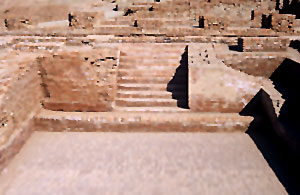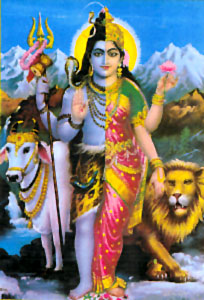 The Harappan civilization extended in the west up to Sutkagen Dor near the modern frontier of Pakistan and Iran while in the east the remains of this culture have been found at Alamgirpur in Meerut district, in the north it is extended up to Manda in Jammu and in the south up to Bhagatrao. On the basis of Carbon-14 dating this culture flourished from C. 2300 to 1750 B.C. Thus it was the most extensive culture of this period.
The Harappan civilization extended in the west up to Sutkagen Dor near the modern frontier of Pakistan and Iran while in the east the remains of this culture have been found at Alamgirpur in Meerut district, in the north it is extended up to Manda in Jammu and in the south up to Bhagatrao. On the basis of Carbon-14 dating this culture flourished from C. 2300 to 1750 B.C. Thus it was the most extensive culture of this period.
No buildings have so far been discovered in the remains associated with this culture, which may be definitely regarded as temples. For reconstructing the religion of these people their testimony of seals, sealing, figurines or stone images should be taken into consideration. The Harappan script has not yet been satisfactorily deciphered hence our knowledge of the religious beliefs of these people is limited. A number of figurines of terracotta and earthenware etc. standing or seated show a semi-nude female, wearing a girdle round her loins with an elaborate headdress and necklace. It is also sometimes seen with an ear ornament. Some of the figures are smoke-stained which makes us conclude that these figures were objects of worship and perhaps oil or incense was burnt before them. These figures are rightly taken to represent mother-goddess or Shakti. The worship of Divine Mother or Earth goddess is referred in the Rigveda. Rigveda calls the Earth by the names of Aditi, Prthvi or Prthivi. In the Tahtiriya Brahmana the Earth goddess is called Prthivlm Mataram. Thus it is clear that the Vedic Aryans also worshipped the mother goddess.
A sealing from Harappan shows a nude female figure, turned upside down with outspread legs and a plant issuing from the womb. On the reverse of this sealing is depicted a man with a sickle in his hand and a woman seated on the ground with hand raised in the posture of prayer. Obviously this depicts human sacrifice in honour of the Mother-goddess.
 Among the male deities the most important is a three-faced deity wearing a horned dress and seated cross-legged on a throne with penis erectus. The god is surrounded by a number of animals such as elephant, tiger, buffalo, rhinoceros and deer. This deity has three features of Siva as for example he is three faced i.e. trimukha, the lord of animals i.e. pasupati and a Yogi. Hence this deity has been called proto-Siva. Buddha Prakash, however, lays emphasis on the absence of Nandi, the vehicle of Siva and thinks that it will be more appropriate to identify the deity with Prajapati or Twastr from which emanates the creation. The figure tallies with the description of Twastr, in the Rigveda. He is called the lord of animals and an incarnation of the creator in this universe.
Among the male deities the most important is a three-faced deity wearing a horned dress and seated cross-legged on a throne with penis erectus. The god is surrounded by a number of animals such as elephant, tiger, buffalo, rhinoceros and deer. This deity has three features of Siva as for example he is three faced i.e. trimukha, the lord of animals i.e. pasupati and a Yogi. Hence this deity has been called proto-Siva. Buddha Prakash, however, lays emphasis on the absence of Nandi, the vehicle of Siva and thinks that it will be more appropriate to identify the deity with Prajapati or Twastr from which emanates the creation. The figure tallies with the description of Twastr, in the Rigveda. He is called the lord of animals and an incarnation of the creator in this universe.
Two other seals show this deity with a twig of flowers or leaves rising from his head between the horns. The sprig suggests that the deity was associated with vegetation or fertility. This deity was worshipped not only in the human form but also in the form of phallus or iiriga. This can be proved as a number of conical stones have been discovered in the excavations. The references to non-Aryans in the Rigveda proved that the Harappan people were worshippers of phallus. In Rigveda the non-Aryans are called worshippers of phallus i.e. Sisna-devah.
Small ring stones found in the excavations suggest that worship of Yoni i.e. the female symbol of generation was also prevalent. But the worship of linga was always dominant. A seal from Mohenjodaro shows a standing deity between two branches of a tree. It is shown being worshipped by seven female devotees in a line with a mythical animal figure as the vahana or vehicle of the goddess. The tree is identified as Pipal tree. This shows that the worship of Pipal tree was also prevalent among the Harappan people. Seals also portray figures of animals as objects of worship. Some of these animals are mythical while of others are real. They are shown eating offerings of food as objects of worship. The worship also includes profusely decorated with ornaments. From the above account it is clear that the Harappan people also worshipped animals. They might have been considered sacred as vahanas of deities e.g. the bull of Siva, the lion of Durga, the buffalo of Yama, the ram of Brahma and the elephant of Indra. From an earthenware tablet it appears that some form of Naga worship was also practiced by these people. In this tablet a seated deity is shown with a hooded cobra on his head. The worshippers are shown seated on either side of the deity.
 Some six seals portray standing yogis who may be taken to be Jain ascetics in the Kayotsarga posture. The worship of fire also seems to have been known to the Harappan people as a number of fire altars have been found on raised platforms at Kalibangan in Rajasthan. The direct evidence of water worship has been found in the form of the Great Bath at Mohenjodaro. This shows that ceremonial ablutions formed a feature of the religion of the Harappan people.
Some six seals portray standing yogis who may be taken to be Jain ascetics in the Kayotsarga posture. The worship of fire also seems to have been known to the Harappan people as a number of fire altars have been found on raised platforms at Kalibangan in Rajasthan. The direct evidence of water worship has been found in the form of the Great Bath at Mohenjodaro. This shows that ceremonial ablutions formed a feature of the religion of the Harappan people.
The representations on some seals of Svastika and the wheel suggest that the Sun was represented symbolically. From the figures on some other seals it appears that the Harappan people considered the numbers three, five, seven and sixteen sacred. According to Buddha Prakash, three stands for the three elements namely, mind or manas, vital breath or prana and sacred speech or vale. Like this five stands for five varieties of each of the elements and seven stands for mind or manas, vital breath or prana and five elements namely fire, water, air, sky and earth. The number sixteen probably represents five kinds of each of manas, prana and vak together with the Supreme Being. In the Vedas the whole is called Sodasi Prajapati.
These people had a belief in life after death. The dead bodies, therefore, were either buried or after cremation, their remains were preserved in a jar. With the dead bodies the Harappan people also buried animals, birds, fish, beads, bangles, etc. so that the dead person might use them in need.
It seems that the common people had full faith in witchcraft. It is possible that some of these seals were used as amulets. In the past scholars have generally believed that the Harappan civilization was different and prior to the culture of the Vedic period. However, there are some similarities in the religious beliefs of these cultures. So long as the Harappan script is not satisfactorily deciphered the problem of the relationship of the two cultures cannot be solved with any amount of certainty.
But it is beyond doubt that modern Hinduism is indebted to a great extent to the religious beliefs of the Harappan people. The worship of Siva and Sakti both in human and symbolic form, worship of stones, trees and animals, and the worship of Nagas, Yaksas, etc., which are embodiments of good or evil spirits, can all be traced to Harappan culture. Even traces of offering into fire were considered a distinctive feature of the Vedic religion could be seen at Kalibangan in the form of fire altars.






































